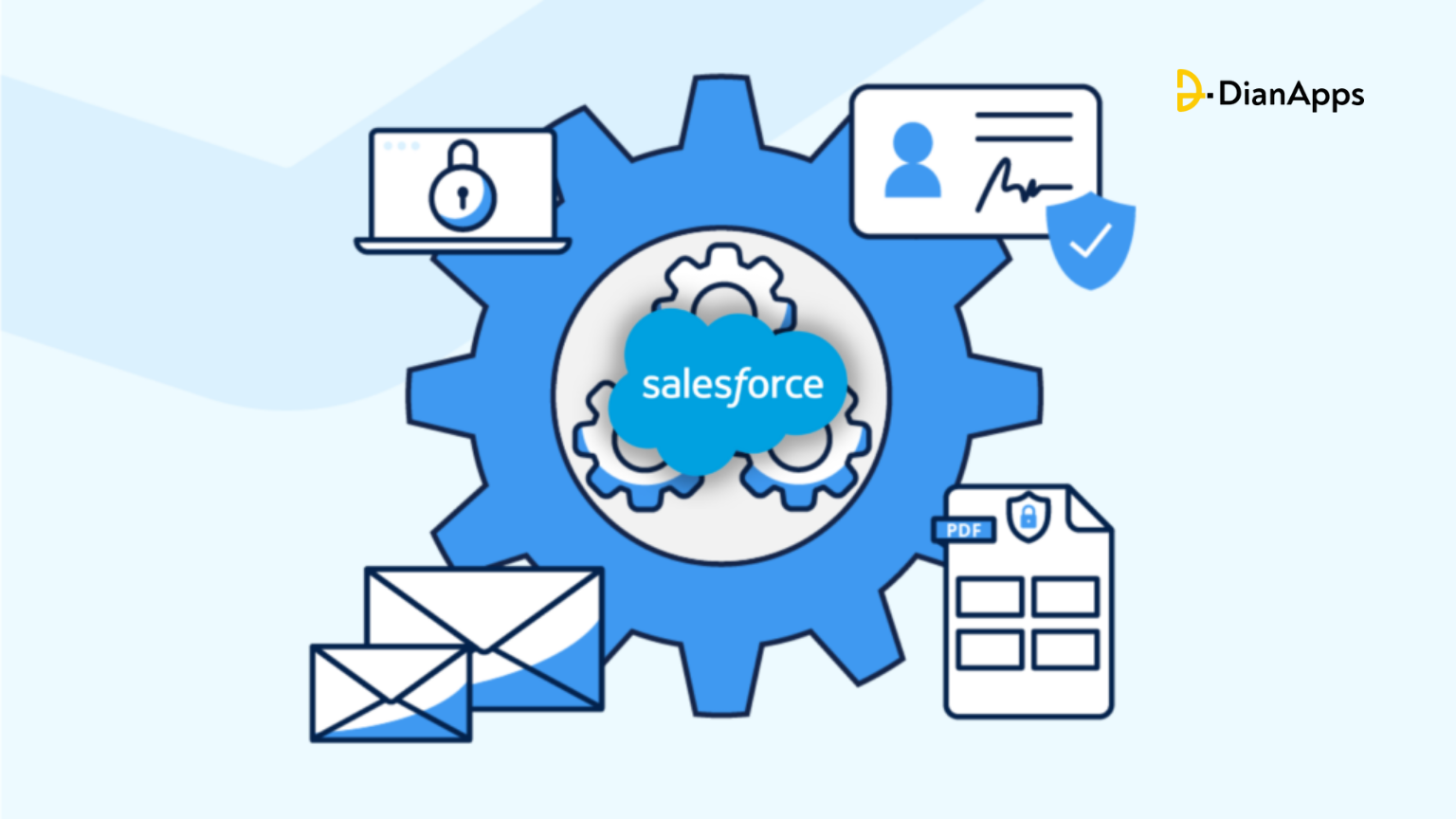Maximizing Sales Productivity with Salesforce Automation
Want to sell faster while increasing sales productivity simultaneously? Salesforce Automation is the key to accomplishing long-term success.
Salesforce being a core drive to manage leads and offer tools to improve productivity, businesses can boost their sales efficiency by indulging in Salesforce automation best practices.
According to 60% of sales professionals, Automation tools are an integral part of overall business strategies. On top of that, 91% of the organizations say demand for automation from business teams has increased over the past two years.

By implementing Salesforce automation, companies can experience a myriad of benefits. Automation helps businesses make data-driven choices and maximize their sales strategies by decreasing the need for human data entry, removing mistakes, and providing insightful Salesforce analytics for sales optimization and reporting.
Additionally, companies may increase conversion rates and shorten the sales cycle with tools like lead scoring and automatic follow-ups. This post explores how Salesforce automation can boost your sales efficiency, including its main advantages and recommended practices.
Let’s understand the definition of Salesforce Automation.
What do you mean by Salesforce Automation?
The term “Force automation” describes how technology and software are used in an organization to simplify and automate various operations, procedures, and duties associated with sales. It is an essential part of customer relationship management (CRM), enabling companies to manage their sales activities better and more successfully.
Maximizing Salesforce Automation Benefits
Salesforce automation has a number of important advantages that can help a company increase sales productivity. Among these advantages are:
Streamlined Sales Processes:
By automating and streamlining a variety of sales operations, Salesforce automation helps to reduce the time and effort needed to complete repetitive administrative chores. This makes it possible for sales teams to concentrate on more worthwhile tasks like prospecting, closing deals, and cultivating clientele.
Enhanced Productivity:
Sales professionals may do more work in less time by automating monotonous processes like data input, lead assignment, and follow-up reminders. As a result, more activities are linked to sales and a rise in productivity.
Enhanced Lead Management:
Salesforce automation makes it possible to collect, monitor, and distribute leads more effectively. The appropriate sales professionals are automatically given leads, guaranteeing that they are immediately followed up upon, potentially increasing conversion rates.
Improved Contact Management:
Time spent looking up contact information or interaction history is decreased thanks to centralized contact databases, which offer quick access to customer and prospect data. This guarantees that sales representatives are equipped to engage with leads and consumers.
Improved Opportunity Management:
Sales teams may more efficiently handle and rank their opportunities with the use of sales automation solutions. They can monitor how transactions move through the sales funnel and get alerts for important tasks, which enables them to close deals faster.
Task and Activity Management:
Sales representatives may plan and automate appointments and activities to keep on top of things and never forget crucial meetings or follow-ups.
Workflow Automation:
Workflows and automation rules may be configured to initiate activities in response to particular circumstances. This can be useful for nurturing leads, delivering tailored communications, and automating regular correspondence.
Error Risk Reduction:
Data input and other manual procedures may be made more error-proof by automating them. This guarantees the accuracy and currency of consumer data.
Sales Reporting and Analytics:
Real-time insights into sales performance are provided by Salesforce automation. Sales managers have access to dashboards and reports that help them monitor team performance, spot bottlenecks, and make data-driven choices that improve their sales tactics.
Enhanced Collaboration:
Features that facilitate information sharing, note-taking, and updates on leads and opportunities are frequently included in Salesforce automation systems. Sales professionals benefit from improved collaboration and communication as a result of this.
Scalability:
Salesforce automation grows with a business, allowing it to handle an increase in leads, prospects, and customers without correspondingly rising administrative burden.
Also read about the best ways in which you can automate Project Management in Salesforce
Key Features of Salesforce Automation Tools
Contact management
If the company is to expand, consumer engagement levels must rise. Building a strong rapport with the prospect is just as crucial to getting them to become a client. With the use of Salesforce automation and its contact management system, you may do that.
Salesforce automation can assist in tracking customer contacts in addition to sales operations. Additionally, you are free to access and handle another person’s data.
Contact management is helpful for workers who are seated in an office. They can obtain various consumers’ contact data for marketing efforts without upsetting the sales staff. If needed, they can also amend and update consumer contact information.
Pipeline management
Another crucial component of software for sales force automation is pipeline management. The sales pipeline ends after the client has completed the payment and acquired the item or service. It begins with the customer’s initial inquiry.
You can follow the pipeline from the beginning to the end with the aid of Salesforce automation tools. Additionally, it aids in predicting sales and identifying market trends.
Task management
The sales process is the only factor that influences Salesforce automation. For this reason, sales force automation software enables salespeople to follow up with prospects and maintain a log of all sales activity by automating tasks and reminders into their workflows.
Team Collaboration
The fact that everyone on the team may access sales force automation regardless of location is one of its finest features. To access the data and view the most recent changes, all they would want is an internet browser. Multiple people may access a customer’s account at the same time, forming a central center for the development of your company.
Salespeople who work from home or remotely will also find this helpful. They don’t need many permissions or assistance to update the information; they can log in and do it from anywhere. Since it is accessible, a great deal of time may be saved.
Cloud App Integration
The advent of cloud computing technologies has made sales force automation incredibly user-friendly and convenient. Both big and small businesses have profited from it. It is not only reasonably priced, but it can link several departments centrally to give everyone accurate and comprehensive information.
Additionally, cloud app integration makes it possible to automate data transfer across many departments and systems, which eventually improves process efficiency and boosts output while saving time.
In addition to automating the administrative tasks, you may design a workflow for any associated manual activities. The cloud is also helpful for tracking daily sales figures. Since all data is kept on the cloud, directors and upper management may access the data and see how sales are doing.
Customization of SFA
Another benefit and aspect of this force automation is customization. It may be tailored to meet the needs of various businesses and accessible through tablets, laptops, or smartphones as needed.
Pharma sales representatives utilize it, for instance, for gas meter reading collecting. SFA may be tailored to meet the needs of your position.
Functions of Salesforce Automation
Account Management:
Managers and salespeople may obtain a comprehensive picture of the entire company environment, particularly the Customer Relationship Management aspect, by utilizing SalesForce automation software. It comprises, but is not limited to, the personal information of the customers, previous correspondence, the topic of the conversation, orders and their status, etc.
Contact management:
You may utilize it to track and update consumer contact information, such as email addresses, phone numbers, and addresses.
Document management is useful for organizing and keeping track of product specs, manuals, brochures, and other materials.
Event Management:
Conferences, sponsored events, trade exhibits, seminars, meetings, webinars, and other events may all be managed with the use of SFA software. Events may include clients or staff members from inside.
Contract Management:
It might not be obvious to a recently hired employee that there have been several contracts completed with the clients in the past. Contract management allows for the storage and retrieval of both the actual contracts and all of its data.
Lead and Opportunity Management:
This type of business support assists with lead generation, opportunity creation, and current opportunity management.
Quotation Management:
Sales teams may produce, modify, and finalize sales quotes for customers with the use of the program.
Sales Visualization and Prediction:
It enables the user to create a three-dimensional product model and supports the sales representative in managing sales projection data.
Implementing Salesforce Automation in Your Sales Process
A smart move that may greatly increase sales effectiveness and efficiency is integrating Salesforce automation into your sales process. The following stages will help you navigate the installation process:
Establish Your Goals:
Clearly state the aims and goals you have for using Salesforce automation. This might entail raising income, reducing sales cycles, or enhancing lead conversion rates. It is crucial to set SMART (specific, measurable, attainable, relevant, and time-bound) goals.
Choosing the Best Salesforce Automation Solution:
Do your homework and pick a solution that will work for your organization, your budget, and your technological setup. Salesforce, HubSpot, Zoho CRM, and many more are well-liked choices. Take into account integration and scalability as well.
Form a Cross-Functional Team:
Engage important players from several departments, including as IT, customer service, sales, and marketing, in the implementation process. Success requires the collaborative contributions and thoughts of others.
Data Migration and Cleanup:
Make sure the information you currently have on your clients and prospects is correct and arranged. Transfer this data to the Salesforce automation tool and, if needed, tidy it up to get rid of mistakes and duplicates.
Customize and Configure the System:
Tailor the Salesforce automation tool to meet your specific sales processes. Adapt fields, processes, and automation rules to your particular business needs. Determining lead phases, sales funnels, and automated triggers are a few examples of this.
Training and User Adoption:
Educate your sales force and other pertinent staff members on the proper usage of the Salesforce automation system. To promote adoption, make sure they comprehend the advantages and how it fits into their regular routine.
Automation Rules and Workflows:
Automate common processes like lead assignment, email notifications, and follow-up reminders by setting up automation rules and workflows. Make sure these guidelines complement your sales tactics and are intended to increase productivity.
Training Materials and Documentation:
Provide training materials and documentation that users may refer to. Maintain these resources current to facilitate further onboarding and training.
Measurement and Reporting:
Keep tabs on and provide regular reports on key performance indicators (KPIs) that are associated with your sales goals. Make decisions based on facts by utilizing the insights obtained by Salesforce automation.
Feedback and Refinement:
User input should be gathered, and the system should be continuously improved as needed. Your Salesforce automation procedures should adapt to the changes in your business.
Keep in mind that setting up Salesforce automation is a continuous activity rather than a one-time thing. It has to be continuously improved and adjusted to fit shifting industry trends and corporate demands.
Training and support for Salesforce automation implementation
Training and support are crucial aspects of a successful Salesforce automation implementation. Effective training ensures that your team can use the system efficiently, while ongoing support helps address any issues or questions that arise during and after implementation. Here’s a breakdown of training and support strategies for Salesforce automation:
Training:
- Needs Assessment: Start by assessing the specific training needs of your team. Consider the roles of various users (e.g., sales representatives, managers, administrators) and tailor training programs accordingly.
- Customized Training Modules: Create customized training modules that focus on different aspects of the Salesforce automation system. These modules should align with your business processes and objectives.
- Onboarding Training: Provide comprehensive onboarding training for new users. This should cover the basics of the system, data entry, lead management, opportunity tracking, and reporting.
- Advanced Training: Offer advanced training for experienced users or those in specialized roles. This can include in-depth training on automation rules, workflows, and data analytics.
- Hands-on Workshops: Conduct hands-on workshops and simulations that allow users to practice using the system in a controlled environment. This can help solidify their understanding of the platform.
- Role-Specific Training: Tailor training sessions to the roles and responsibilities of your team members. For example, sales representatives may need training on lead management, while managers may need training on reporting and analytics.
- Continuous Learning: Offer ongoing learning opportunities, such as webinars, video tutorials, and documentation. Encourage users to stay updated on new features and best practices.
- Feedback Loops: Establish feedback mechanisms to gather input from users about the effectiveness of training materials and sessions. Use this feedback to improve training programs.
Support:
- Dedicated Support Team: Designate a support team or helpdesk responsible for assisting users with questions, issues, and troubleshooting. Ensure that this team is knowledgeable about the Salesforce automation system.
- User Communities: Encourage users to participate in Salesforce user communities and forums, where they can ask questions, share insights, and learn from others who use the platform.
- Documentation and Knowledge Base: Create and maintain a comprehensive documentation and knowledge base with FAQs, guides, and troubleshooting resources. Make these materials easily accessible to users.
- Regular Check-Ins: Schedule regular check-in meetings or calls with users to address concerns and questions. These can help identify and resolve issues before they become major problems.
- Problem Resolution Process: Establish a clear process for reporting and resolving issues. This might involve a ticketing system to track and prioritize support requests.
- Escalation Procedures: Define escalation procedures for more complex issues that may require higher-level support or technical assistance.
- User Champions: Identify and empower user champions within your organization. These individuals can help other users and act as liaisons between users and the support team.
- Feedback Collection: Continuously gather feedback from users about their experiences and challenges with the system. Use this feedback to make improvements and refine your support processes.
By providing effective training and ongoing support, you can ensure that your team not only adopts Salesforce automation but also uses it to its full potential, maximizing the benefits for your organization.
Success stories and case studies of companies that have used Salesforce automation to boost sales efficiency
Coca-Cola:
Coca-Cola implemented Salesforce automation to streamline its sales processes. By providing their sales team with a centralized platform, Coca-Cola improved lead management, opportunity tracking, and reporting. The result was increased sales efficiency and better customer relationship management.
GE Healthcare:
GE Healthcare, a division of General Electric, leveraged Salesforce automation to improve sales processes and customer engagement. They used Salesforce to create a unified platform for their global sales teams, enabling them to manage leads, opportunities, and customer information more effectively.
Spotify:
Spotify used Salesforce automation to manage its advertising sales processes. By automating lead generation and tracking, they were able to increase the efficiency of their sales team and better target potential advertisers. The platform also helped with revenue forecasting and pipeline management.
American Express:
American Express implemented Salesforce automation to enhance its customer relationship management and sales processes. They used the platform to centralize customer data, improve lead management, and provide sales representatives with valuable insights. This led to more efficient sales operations and a better customer experience.
Fujitsu:
Fujitsu, a global information technology company, used Salesforce automation to optimize its sales and marketing efforts. The system allowed them to align sales and marketing teams, streamline lead management, and create personalized customer experiences. This resulted in increased sales efficiency and revenue growth.
T-Mobile:
T-Mobile, a major telecommunications company, employed Salesforce automation to improve its sales operations. The platform enabled them to manage leads, opportunities, and customer data more effectively, resulting in reduced administrative overhead and faster sales cycles.
Fitbit:
Fitbit, a wearable fitness technology company, utilized Salesforce automation to enhance its lead management and sales processes. The system helped them capture and nurture leads more efficiently, ultimately increasing their sales conversions and revenue.
These are just a few examples of how companies have leveraged Salesforce automation to boost sales efficiency. Salesforce automation is a versatile tool that can be tailored to meet the unique needs of various industries and organizations, leading to improved sales operations, better consumer engagement, and increased revenue.
For the most up-to-date and detailed success stories, we recommend visiting the Salesforce website or other reputable sources that provide case studies and customer testimonials.
Wrapping Up
By now, it must be clear to you that Salesforce automation is one of the most effective tools for increasing sales productivity in your company, especially with the support of a Salesforce consulting company. By automating repetitive operations, handling leads and prospects effectively, and providing insightful information through reporting and analytics, Salesforce puts your sales staff in a position to focus on developing connections and completing transactions.
Adopting Salesforce automation is a smart move that may result in more income and business expansion, helping you beat the competition and raise your sales efficiency.




